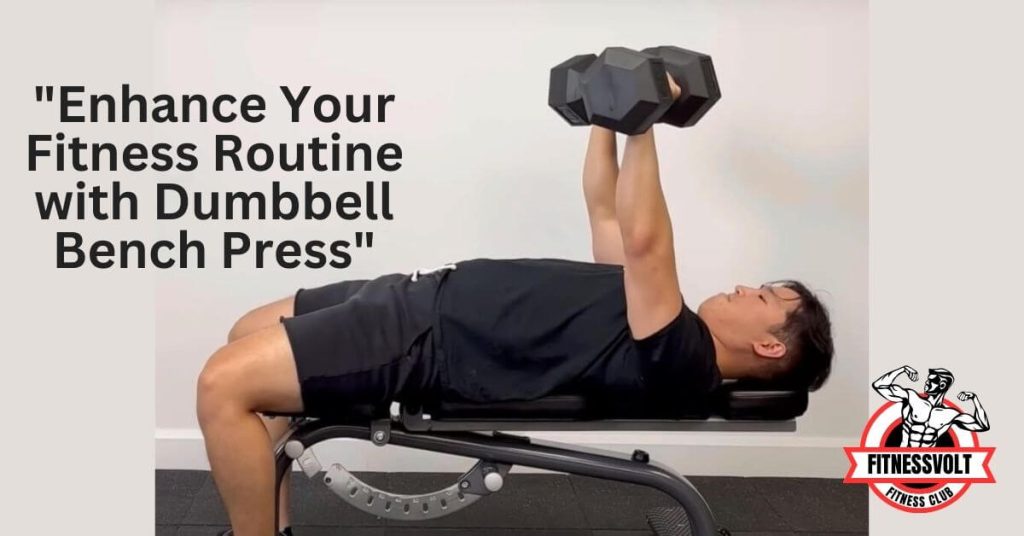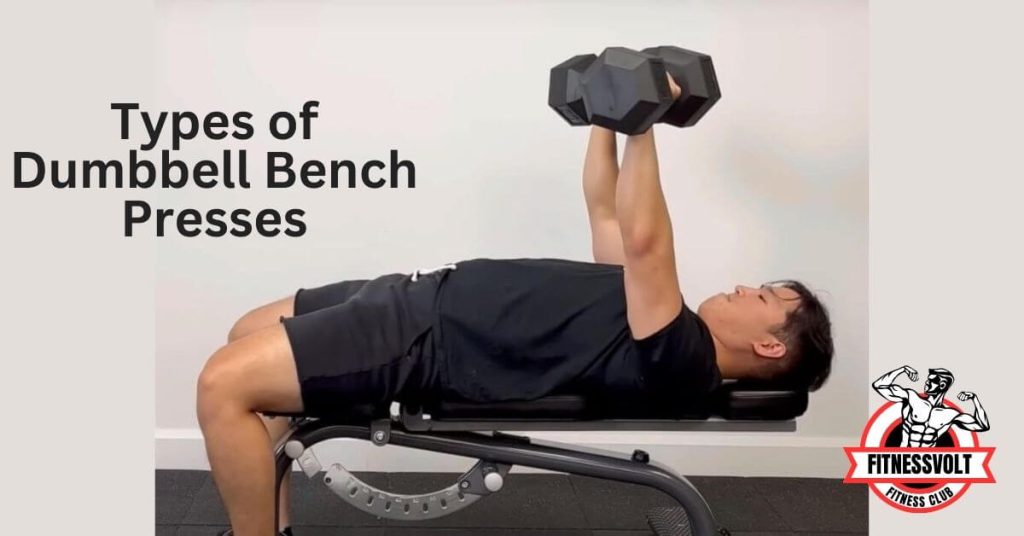The dumbbell bench press is a popular exercise in weight-training workouts, it works the upper body, mainly the chest and triceps. And if you’re an old pro in the weight room or a newer gym-goer, knowing your dumbbell bench presses could take your strength game to the next level. So why use dumbbells instead of the traditional barbell?
In simple words, Dumbells allow More range of motion and per-limb engagement which can help in overcoming muscle imbalances. Moreover, they are gentler on your joints. In this post, you will discover more about this exercise and how you can use it to build an incredible routine.

What is a Dumbbell Bench Press?
Dumbbell Bench Press: This is a free weight exercise that focuses on the Pectoral muscles, Triceps, and Shoulders. This exercise is performed by lying on a bench and pushing two dumbbells from chest level upwards until your arms are locked out completely.
The dumbbell bench works the two sides of your chest independently from each other and therefore promotes even muscle development better than the barbell bench.
Types of Dumbbell Bench Presses

There are several different versions of the dumbbell bench press you can perform to keep your workouts varied and effective that target slightly different areas of the chest and each provides its own benefits.
Flat Dumbbell Bench Press
This is the version you see most people do all the time, which involves lying on a flat bench and pressing dumbbells straight up. If we go back to the video, with a pause at 0:25, we can see what area this exercise primarily affects the middle part of the pectoral muscles.
Incline Dumbbell Bench Press
Raising the bench slightly off horizontally (usually from 30 degrees to 45 degrees) can place more emphasis on the upper chest. This one also makes more effort on the shoulders.
Decline Dumbbell Bench Press
This variation specifically hits the lower chest and is performed with a bench set at an incline of 15-30 degrees downwards. This will give a balanced head to your chest for those looking to build an overall big TRACTOR LIKE CHEST.
Alternating Dumbbell Bench Press
You plant the other one at chest level and press one dumbbell over the head by alternating arms. This adds an element that requires even better stability and core engagement.
Single-Arm Dumbbell Bench Press
As chest exercise but also your core Is really challenged your body cannot tilt, and this exercise is unilateral. Great as for self-diagnosing and addressing imbalances between the sides of your body.
Neutral Grip Dumbbell Bench Press
Holding the dumbbells in a neutral grip will reduce the amount of strain placed on your shoulders while executing this movement, making it more shoulder-friendly for those who suffer from shoulder issues.
How to Perform a Basic Flat Dumbbell Bench Press?

Here’s a step-by-step guide to performing the flat dumbbell bench press correctly:
- Set Up: Lie flat on a bench with your feet firmly rooted to the floor. Place a free weight in each hand and rest the weights on your thighs.
- Get Into Position: Lie back and bring the dumbbells to chest level with your palms facing forward, using your legs to help you lift.
- Press: Push the dumbbells up toward the ceiling, keeping your arms long but not locked and extended. Make sure to keep your wrists straight and bend at the elbow up top.
- Lower: Pause at the top, then lower the dumbbells back to the starting position with control.
- Repeat: Do as many reps as you wish, while ensuring smooth and controlled movement.
Common Mistakes to Avoid
- Arching the Back: Keep your lower back pressed against the seat, so as not to overburden.
- Flared Elbows: Prevent damage to your shoulder joints by keeping your elbows at a 45-degree angle from the body.
- Rushing the Reps: QUALITY of reps over speed.
Incline Dumbbell Bench Press
The incline dumbbell bench press shifts the emphasis to your upper chest and shoulders. Here’s how to do it:
- Adjust the Bench: Bench: 30-45 degree incline
- Position Yourself: Lie back holding a dumbbell in each hand at your chest.
- Press: Raise the dumbbells up, arms full way extended. Be sure to move slowly and control this movement.
- Lower: Slowly lower the dumbbells back to the starting position.
Benefits
- Training the upper chest better
- Greater shoulder activation.
Decline Dumbbell Bench Press
The declined dumbbell bench press is excellent for targeting the lower chest.
- Adjust the Bench: Set it at a slight decline.
- Position Yourself: Lean back and secure your feet under the pads if you can.
- Press: The dumbbells should be pressed directly upwards (the same as a flat bench press) but at an angle going down.
- Lower: Gradually move back to the beginning posture.
Common Mistakes
- Improper Angle: Just make sure the bench isn’t so steep that it affects your form and safety.
- Rushing the Movement: Control is key, especially when you’re going down.
Alternating Dumbbell Bench Press
The alternating dumbbell bench press adds a stability challenge to the standard press.
- Position Yourself: Lie down with both tables one in one hand.
- Press One Arm: Raise 1 dumbbell and maintain the other at chest height.
- Alternate: Press the other one up as you lower the first dumbbell.
Benefits
- Enhanced core stability.
- Enhanced core stability.
Single-Arm Dumbbell Bench Press
This variation takes unilateral training to the next level by involving only one arm at a time.
- Position Yourself: Lie flat with one dumbbell.
- Press: Push the dumbbell up using your one arm.
- Engage Your Core: Active Your Core To Prevent The Body From Tipping By.
When to Incorporate
- Excellent for muscle imbalance correction.
- Superb for those more experienced lifters intending on really testing their core stability.
Neutral Grip Dumbbell Bench Press
The neutral grip is a shoulder-friendly variation that can help prevent injuries.
- Position Yourself: Then you will come back to the starting position with a single focus on control.
- Press: As you push the dumbbells up, keep them with a neutral grip.
- Lower: Then you will come back to the starting position with a single focus on control.
Targeted Muscles
- The Same As The Flat Bench But Safer On Your Shoulders.
Dumbbell Bench Press for Beginners
For those new to the dumbbell bench press, starting light and focusing on form is crucial. Here are some tips:
- Start Light: Pick a weight that you can do for 10-15 reps no problem.
- Focus on Form: Great form over big weights. Make sure your repeats are done the right way.
- Consistency: It just requires regular practice due to which it leads to slow strength and muscle gains.
Advanced Dumbbell Bench Press Techniques
Once you’ve mastered the basics, try these advanced techniques to keep challenging your muscles:
- Tempo Variations: Increase time under tension by slowing down the lowering phase.
- Pauses: Hold for a brief moment at the bottom to remove momentum and add challenge.
- Drop Sets: When you get to failure, drop the weight a bit and finish the set off with an intense burn.
Common Mistakes and How to Avoid Them
To get the most out of your dumbbell bench presses, avoid these common pitfalls:
- Arching Your Back: Lower Lumbar Stress Squeeze your core hard and keep your back flat.
- Flared Elbows: Wrap your elbows a bit to the sides for shoulder security.
- Holding Your Breath: Exhale to press, and inhale as you lower.
Benefits of Dumbbell Bench Press vs. Barbell Bench Press
So, should you ditch the barbell entirely? Not necessarily. But here’s why dumbbells might be the better choice for many:
- Greater Range of Motion: At the bottom of a press the dumbbells allow you to get a better stretch and in turn get Better and bigger contraction.
- Individual Limb Engagement: Assitance with Muscle Imbalances and Balanced Growth
- Joint-Friendly: The flexibility allows you to move freely so that your shoulders bear less stress.
Incorporating Dumbbell Bench Press into Your Workout Routine
For a well-rounded chest workout, incorporate dumbbell bench presses with other exercises. Here’s a sample routine:
- Day 1: Flat Dumbbell Bench Press – 4 sets of 8-12 reps
- Day 2: Incline Dumbbell Bench Press – 4 sets of 8-12 reps
- Day 3: Decline Dumbbell Bench Press – 3 sets of 10-15 reps
- Day 4: Alternating or Single-Arm Dumbbell Bench Press – 3 sets of 8-12 reps on each arm
Perform these exercises 2-3 times a week, ensuring to rest adequately between sessions.
Conclusion
Dumbbell Bench Press: One of the most versatile and effective exercises for a powerful, balanced chest. There are various forms and techniques of strength training, which can be modified to suit your individual fitness goals whether you are a novice or experienced lifter. Scroll down for the absolute best tricep exercises you can work into your routines RIGHT NOW and zero in on that perfect form to keep yourself moving forward without some of the basic. Then grab those dumbbells and start pressing your way to a stronger upper body.


